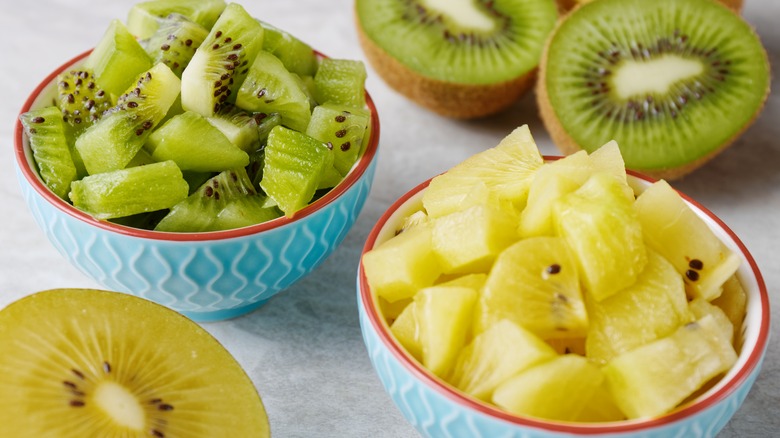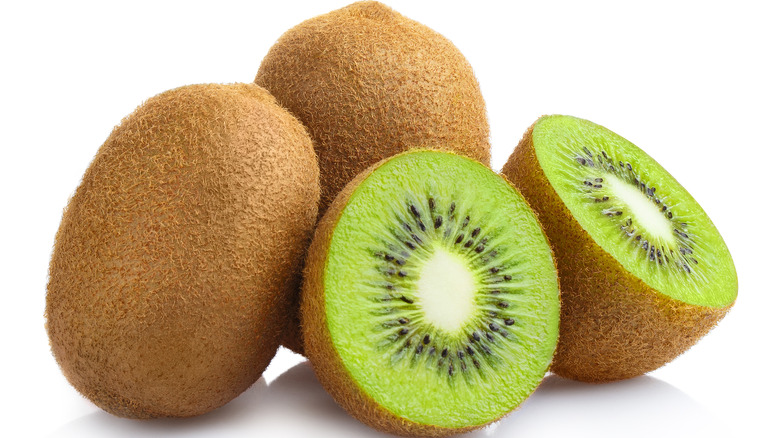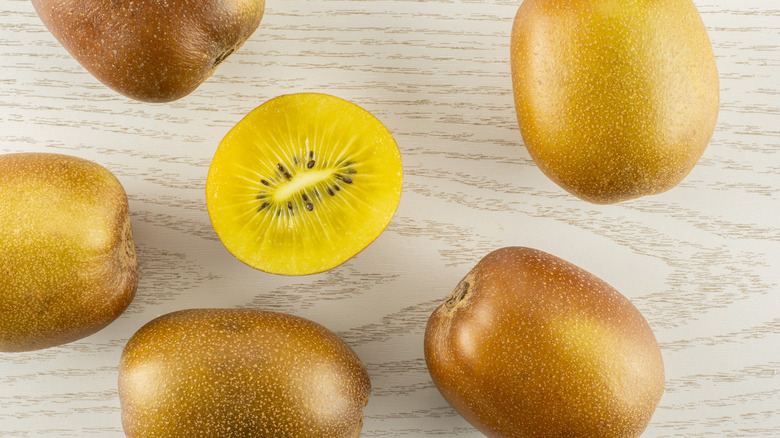Green Vs. Gold Kiwi: What's The Difference?
It's hard not to love the quirky little kiwi. The fuzzy brown fruit grows on a vine called Actinidia deliciosa, and Science of Cooking explains that though it's native to China, it was first produced commercially in New Zealand in the 1940s. Isabel Fraser had been the first to bring kiwi seeds back with her from China to New Zealand, where they were first planted in 1906 and the first fruit harvested in 1910. Because the little brown fruit tasted a bit like a gooseberry, New Zealanders initially called it the Chinese gooseberry, though there's no relation between the two plants.
The name "kiwi fruit" was a marketing decision made by a New Zealand fruit and vegetable exporter in 1959, and naming the fruit after one of the flightless birds native to New Zealand was a popular move. The official trade name became kiwi fruit in 1974. While U.S. consumers find the kiwi beguiling and the skin a little perplexing, new varieties of kiwi make the fruit even more interesting. Is there really a difference between the familiar green-fleshed kiwi we know and love and its newer golden sibling?
Green kiwi: Tart and delicious
The kiwi most consumers know is the green-fleshed fruit, which is full of palate-pleasing acidity and a sweet, citrusy flavor. Though World Atlas demonstrates that the largest worldwide producer of kiwi is China, followed by Italy and then New Zealand, one of the most commonly found brands of kiwi in the U.S. is New Zealand-based Zespri. Zespri produces and exports both green and gold kiwi, and they explain the many differences.
Both green and gold kiwi are nutritious fruits, though they're not nutritionally identical. One serving of green kiwi, two pieces of fruit, contains 90 calories, 1 gram of fat, 2 grams of protein, 462 milligrams of potassium, and 137 milligrams of vitamin C, which is 150% of the USRDA. According to Science Learning Hub, kiwi exporting is big business for New Zealand, and when a disease called PSA devastated New Zealand kiwi orchards in 2010, researchers scrambled to find a disease-resistant variety of kiwi. The variety they settled on is now known as Zespri's Sungold kiwi.
Sungold kiwi: Tropical sweetness
Gold kiwi were cultivated in New Zealand prior to the development of the Sungold variety, also from seeds brought directly from China to New Zealand, according to Science of Cooking. It is Zespri's Sungold, though, that's been widely distributed, and even kicked off a massive lawsuit between New Zealand and a man named Haoyu Gao, who smuggled Sungold vines to China, where he sold them for big profits and jumpstarted Chinese cultivation of the Sungold variety.
Sungold kiwi aren't only valuable because they are disease resistant; they're also delicious. Zespri describes the Sungold as "invigoratingly sweet" and makes note of its hairless skin, smaller core, and fewer seeds. The texture of this type of kiwi is a bit softer, and some people say it tastes a bit like a cross between a mango and a strawberry. Nutritionally, one serving of the Sungold kiwi contains 100 calories, no fat, 2 grams of protein, 510 milligrams of potassium, and a whopping 261 milligrams of vitamin C, which is 290% of the USRDA. Broaden your kiwi horizons by trying both green and gold kiwi, perhaps in a perfectly balanced fruit salad.


